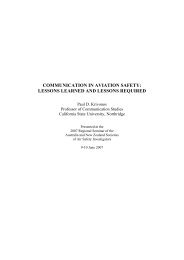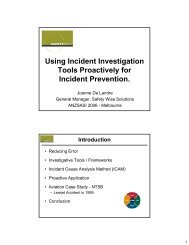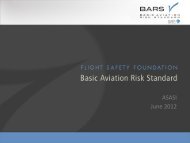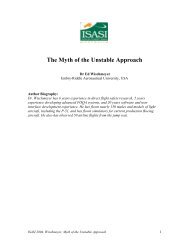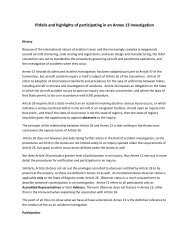Using Incident Investigation Tools Proactively for Incident ... - ASASI
Using Incident Investigation Tools Proactively for Incident ... - ASASI
Using Incident Investigation Tools Proactively for Incident ... - ASASI
You also want an ePaper? Increase the reach of your titles
YUMPU automatically turns print PDFs into web optimized ePapers that Google loves.
_____________________________________________________________________<br />
APPLYING ICAM PROACTIVELY<br />
While ICAM has proved to be an extremely effective reactive tool with the results of ICAM<br />
investigations being used <strong>for</strong> the development of safety per<strong>for</strong>mance improvement strategies,<br />
the future direction <strong>for</strong> incident prevention lies in the proactive use of the model. Proactive<br />
use of the model provides safety learnings to the organisation without the costs associated<br />
with an occurrence. Additional benefit is gained by applying the model to a number of<br />
similar type, low consequence events, to assess what would otherwise be a set of unrelated<br />
safety concerns and to develop strategic recommendations <strong>for</strong> safety improvements (Gibb &<br />
De Landre, 2003).<br />
For incident reduction to ultimately occur, the precursors to error must be identified and<br />
rectified. While reactive investigation tools are required, they do not necessarily describe how<br />
the precursors to incidents are to be identified in the first place. To address this quandary,<br />
error management systems are needed that will reduce error, mitigate their consequences and<br />
there<strong>for</strong>e, proactively prevent incidents.<br />
The facets of the ICAM error management strategy encompass error prevention, error<br />
containment and error mitigation. Figure 2 below page illustrates how the elements of ICAM<br />
Model can be used <strong>for</strong> a 3-way strategy to manage workplace errors, with the defences within<br />
an organisation directed towards error containment and error mitigation and the organisational<br />
factors aimed at error prevention.<br />
Figure 2.<br />
ICAM 3-way strategy to manage workplace errors<br />
In using the ICAM methodology proactively, the terminology alters and the sequence of<br />
examining the elements changes. As a reactive tool, the Investigator arrives at the incident<br />
site and works back through the elements (shown in Figure 1 on Page 3) starting from the<br />
right-hand side. Firstly the Absent / Failed Defences are identified then the Individual / Team<br />
Actions, then the Task / Environmental Conditions and finally the Organisational Factors.<br />
However, as Figure 1 displays with the appearance of arrows, the actual incident originates<br />
back in the Organisational Factors. When using the ICAM methodology proactively as a risk<br />
management model to enhance safety, the terminology changes as indicated on the following<br />
page in Table 2:<br />
___________________________________________________________________________________<br />
~ ANZSASI 2006 : De Landre, Gibb and Walters ~<br />
Page 5 of 12



